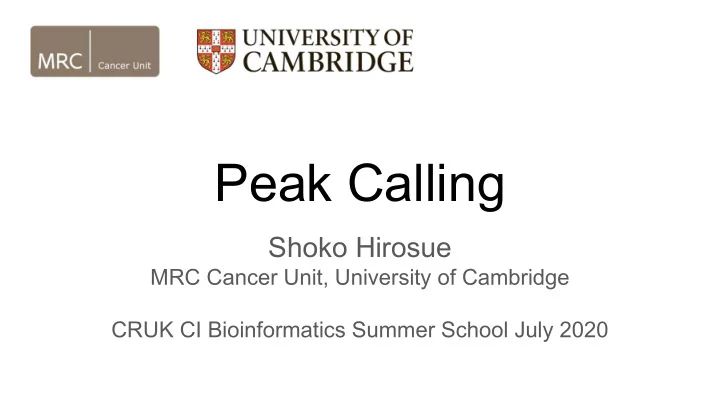

Peak Calling Shoko Hirosue MRC Cancer Unit, University of Cambridge CRUK CI Bioinformatics Summer School July 2020
Peak calling bam bed Adapted from Dora Bihary’s slides
Peak calling bam bed Adapted from Dora Bihary’s slides
Peak calling bam bed Adapted from Dora Bihary’s slides
Bam file (reads)
Bam file (reads)
ChIP input Adapted from Dora Bihary’s slides
Bed file (peaks)
Reads to peaks +ive and -ive strand reads do not represent true binding sites (Strand dependent bimodality) Fragment length d needs to be estimated (if not known) from strand asymmetry in data Bardet et al. Bioinformatics, 2013.
Difference in peak shapes A. For sequence-specific binding events the signal is sharp and shows strong strand dependent bimodality. B. Distributed binding events produce a broader pattern. For most histone marks the signal is expected to be broad with less defined bimodal pattern. Wilbanks et al. 2010 PLOS One
Difference in peak shapes ● Most TF peaks are narrow ● ChIP-seq peaks from epigenomic data can be narrow, broad or gapped. Histone marks such as H3K9me3 or H3K27me3 are broad while others such as H3K4me3 and proteins such as CTCF are narrow ● Other DNA binding proteins such as HP1 , Lamins (Lamin A or B), HMGA etc. form broad peaks or domains. ● PolII peaks can be narrow or broad depending on whether its detecting transcription initiation at the TSS or propagation along the gene body. Sims et al., 2014 Nat Rev Genet.
Peak calling software: MACS2 ● M odel-based A nalysis for C hIP S eq ● Most widely used peak caller ● It was developed for TF bindings, but also suitable for broader regions Useful tutorials: ● MACS project github page https://github.com/macs3-project/MACS/wiki/Advanced%3A-Call-peaks-using-MACS2-subcommands ● Introduction to ChIP-seq using high performance computing https://hbctraining.github.io/Intro-to-ChIPseq/lessons/05_peak_calling_macs.html
Step1: Filter duplicates ‘MACS2 filterdup’ Duplicate reads: reads at the same coordination on the same strand
Duplicates - What do we do with them? ● Duplicates can be artefacts: ○ PCR bias: certain genomic regions are preferentially amplified ○ Low initial starting material can introduce artificially enriched regions with overamplification ● Duplicates can also be “legitimate”: ○ It is unavoidable in highly enriched experiments and deeply sequenced ChIPs since it is naturally increasing with the sequencing depth ● Removing duplicates limits the dynamic range of ChIP signal: ○ Maximum signal/base: one fragment on each strand in each possible position of the read Adapted from Dora Bihary’s slides
Duplicates - What do we do with them? Some approaches: ● Remove all duplicates ● Don’t remove duplicates as long as it has a reasonable rate ● Remove duplicates for some analysis: ○ Remove duplicates before peak-calling ○ Keep duplicates for differential binding analysis ● htSeqTools: ○ Estimate duplicate numbers expected taking into account the sequencing depth and using negative binomial model ○ Attempt to identify significantly outstanding duplicate numbers Adapted from Dora Bihary’s slides
Duplicates - What do we do with them? Some approaches: ● Remove all duplicates ● Don’t remove duplicates as long as it has a reasonable rate ● Remove duplicates for some analysis: ○ Remove duplicates before peak-calling ○ Keep duplicates for differential binding analysis ● htSeqTools: ○ Estimate duplicate numbers expected taking into account the sequencing depth and using negative binomial model ○ Attempt to identify significantly outstanding duplicate numbers Adapted from Dora Bihary’s slides
Step2: Decide the fragment length d ‘MACS2 predictd’ Find treatment regions more than ‘--mfold’ enriched relative to the background MACS randomly samples 1,000 of these high-quality peaks, separates their positive and negative strand reads, and aligns them by the midpoint between their centers. The distance between the two peaks in the alignment (d) is the estimated fragment length.
Step3: Extend ChIP sample Extend reads by d (fragment length) in 5’ to 3’ direction
Step4: Build local bias track from control λ is the expected number ChIP-seq of reads in that window. (parameter of Poisson input distribution) Adapted from Shamith Samarajiwa’s slides
Step5: Identify enriched peak regions 1. Scale the ChIP and control to the same sequencing depth 2. Determine regions with ‘--pvalue’ threshold (Poisson distribution p-value based on λ ) i.e. peaks 3. Overlapping enriched peaks are merged. The location in the peak with the highest fragment pileup (summit) is predicted as the precise binding location. The ration between the ChIP-seq tag count and λ is reported as the fold enrichment. ChIP-seq input
Any questions? Park, 2009, Nat Rev Genetics
References ● CRUK summer school 2019 materials (https://bioinformatics-core-shared-training.github.io/cruk-summer-school-2019/) ● Bardet et al. Bioinformatics, 2013. “Identification of transcription factor binding sites from ChIP-seq data at high resolution” ● Wilbanks et al. 2010 PLOS One. “Evaluation of Algorithm Performance in ChIP-Seq Peak Detection” ● Sims et al., 2014 Nat Rev Genet. “Sequencing depth and coverage: key considerations in genomic analyses” ● Park, 2009, Nat Rev Genetics. “ChIP–seq: advantages and challenges of a maturing technology”
Recommend
More recommend